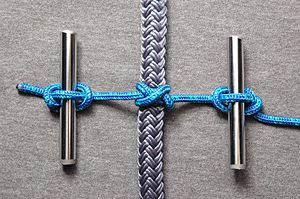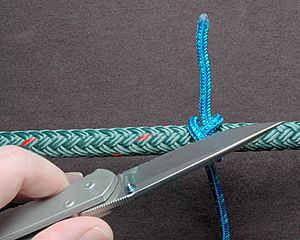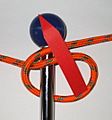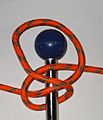Constrictor knot facts for kids
The constrictor knot is a super strong and reliable knot used for binding things tightly. It's simple to tie but can be very hard to undo once it's pulled really tight! It's made a bit like a clove hitch but with an extra twist that makes it super secure. There's also a double constrictor knot which is even stronger!
Contents
History of the Constrictor Knot
The name "constrictor knot" was first used by Clifford Ashley in his famous 1944 book, The Ashley Book of Knots. Even though he wrote about it, the knot itself is much older than that! Ashley helped make the knot well-known to many people.
Before Ashley's book, this knot might have been called the "gunner's knot" in a book from 1866 by someone named Tom Bowling. It was also clearly described in a Swedish book from 1916 as the "timmerknut," which means "timber knot."
The first time the constrictor knot was shown with a picture in a published book was in 1931. A Finnish scout leader named Martta Ropponen included it in her "Knot Book." She learned about it from a Spanish person who called it a "whip knot," saying it was used by mule drivers and herdsmen in the mountains of Spain.
How to Tie a Constrictor Knot
Here's the most common way to tie this useful knot. You can also tie it in a loop first and then slip it over an object.
- Make a loop around the object you want to tie. Bring the working end (the part of the rope you're using) back over the standing part (the main part of the rope).
- Continue wrapping the working end around the back of the object.
- Now, pass the working end over the standing part again. Then, tuck it under the first loop you made and under the standing part. This creates a small knot under the main wraps.
- Make sure both ends of the rope come out between the two main wraps, just like in the picture.
- Pull both ends firmly to tighten the knot. It should feel very secure!
Constrictor Knot Variations
Double Constrictor Knot
If you need an even stronger knot, you can make a double constrictor knot. This is great for slippery ropes or when you need extra holding power. Adding more than one extra wrap doesn't make it much stronger and just makes it harder to tighten.
- Wrap the rope around the object once, bringing the working end over the standing part.
- Make a second wrap, following the exact same path as your first wrap.
- Now, pass the working end over the standing part. Then, thread it back under the standing part and under both of the wraps you just made. This forms a small knot under two wraps.
- Make sure the ends come out between the wraps, just like in the picture.
- The double constrictor might need a bit more care to make sure it's tight all around. Once it's somewhat tight, pull firmly on the ends to finish it.
Slipped Constrictor Knot
This version is handy if you know you'll need to untie the knot later. However, even the slipped version can be tough to release if it's pulled very tight!
- Wrap the rope around the object and bring the working end back over the standing part.
- Continue wrapping around the back of the object, then again over the standing part, bringing it back to the side of your first wrap.
- Now, instead of pulling the end all the way through, pass a small loop (called a bight) of the working end under where the first wrap and the standing part cross. This creates a slip loop.
- Make sure the slip loop and both ends come out between the two main wraps, as shown.
- To release the knot, just pull on the working end, and the loop will come undone.
Uses for the Constrictor Knot
The constrictor knot is perfect for when you need to bind something securely, either for a short time or for a longer period. It works especially well with thin, strong cord because it can squeeze things very tightly.
- When tying over soft things, like the neck of a bag, a stiff cord works best.
- When tying over hard surfaces, a soft, stretchy rope is better.
- Be careful, though! Because this knot bites down so hard, it can sometimes leave marks or damage soft items.
- You can use it to temporarily hold the ends of a rope together, for example, when you're preparing to cut it or join it to another rope.
- It can also be used like a temporary hose clamp or cable tie.
- Some experts even recommend it for use in surgery because it's so reliable!
How to Release a Jammed Constrictor Knot
A constrictor knot that's been pulled very tight can get stuck. If the ends of the rope are long enough, you might be able to untie it by pulling one end parallel to the object and prying it open. Tools like picks can also help.
If the knot is completely stuck or the ends are too short, the easiest way to release it is to cut the main loop (called the "riding turn") with a sharp knife. The knot will immediately spring open once that loop is cut. If you're careful, the other parts of the knot will protect the object underneath from being cut.
Security of the Constrictor Knot
The constrictor knot and the double constrictor knot are both super secure when tied tightly around round or curved objects. They work best on things that are fully curved.
If you're tying it around something with square edges, try to make sure the small knot part of the constrictor is on a corner or a curved part, with the main wrap directly on top of it.
Related pages
Images for kids
-
C: Complete the overhand knot with the main line under both riding turns, entering from left
See also
 In Spanish: Nudo constrictor para niños
In Spanish: Nudo constrictor para niños























